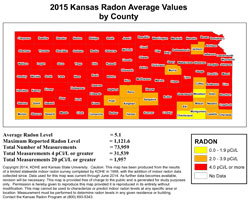Build a radon-resistant new home
January 2016 is National Radon Action Month
 Released: Jan. 25, 2016
Released: Jan. 25, 2016
MANHATTAN, Kan. - Eighty-four of Kansas’ 105 counties are in an area considered to have a high potential for the presence of radon, a naturally occurring gas linked to lung cancer produced by radioactive decay in the soil.
Those 84 counties are in what the Environmental Protection Agency has designated as Zone 1. Of Kansas' remaining 21 counties, 18 fall into Zone 2, with a medium potential for the harmful gas, which can seep through joints and cracks in a slab, basement, or other structural foundation in contact with the soil. The remaining three counties fall into Zone 3, or low potential for elevated indoor radon levels.
Should homeowners be concerned?
“Yes,” said Bruce Snead, director of engineering extension at Kansas State University.
“Radon is a colorless, odorless and tasteless gas, the leading cause of lung cancer in non-smokers, and the second-leading cause of lung cancer in smokers,” he said. Radon is thought to be present in elevated levels in as many as one in three existing homes in Kansas.
While testing is the only way to detect the presence of radon in existing homes, Snead noted that testing a new home is just as important, because new homes have the same potential for radon as existing homes.
If building a new home, however, Snead urged homeowners to work with their builder to choose building methods known to deter radon and simplify mitigation if, once completed, a home tests positive for radon.
To build a radon-resistant home, he suggests checking with the local building code official to see if the International Residential Building Code and Appendix F have been adopted by your city or town. Five communities in Kansas -- Manhattan, Topeka, Lawrence, Salina, and Junction City -- have adopted a stand-alone ordinance modeled on Appendix F. If you are planning to build in a community without the code/ordinance in place, Snead still recommends working with the builder to incorporate the design and construction requirements into the home.
Building a radon-resistant home revolves around five key concepts, he said.
1) Install a four-inch layer of clean, coarse gravel beneath the slab to create a gas permeable layer to allow gas from the soil to move freely underneath the structure. Installing a loop of perforated pipe or soil gas collection mat (if sand or other soils are used underneath a slab) also is an option.
2) Place plastic sheeting on top of the gas permeable layer to prevent soil gas from entering the home; such sheeting also can keep concrete from clogging the gas permeable layer when a slab is poured.
3) Install a three- to four-inch PVC or other gas-type pipe commonly used for plumbing from the gas permeable layer up through the house to vent radon through the roof and out of the home. Labeling potential vent pipes is recommended, as otherwise such pipes may be confused with plumbing pipes.
4) Install and wire an electrical junction box near the pipe to simplify later installation of a vent fan to remove radon found in the home.
5) Seal and caulk the concrete foundation and floor to prevent soil gas from entering the home.
Building a radon-resistant home may add $300 to $500 to building costs, which is less than the $1,000 to $1,200 or more to mitigate radon if later found in the home.
More information about radon and building a radon-resistant home is available from K-State Research and Extension offices throughout the state; from the Kansas Radon Program, based at Kansas State University or 1-800-693-5343; and from the EPA. The EPA’s National Radon Program Services is housed in the Engineering Extension Department at K-State.
-30-
K-State Research and Extension is a short name for the Kansas State University Agricultural Experiment Station and Cooperative Extension Service, a program designed to generate and distribute useful knowledge for the well-being of Kansans. Supported by county, state, federal and private funds, the program has county Extension offices, experiment fields, area Extension offices and regional research centers statewide. Its headquarters is on the K-State campus in Manhattan.
For more information, contact:
Bruce Snead is at 785-532-6026 or bsnead@ksu.edu
